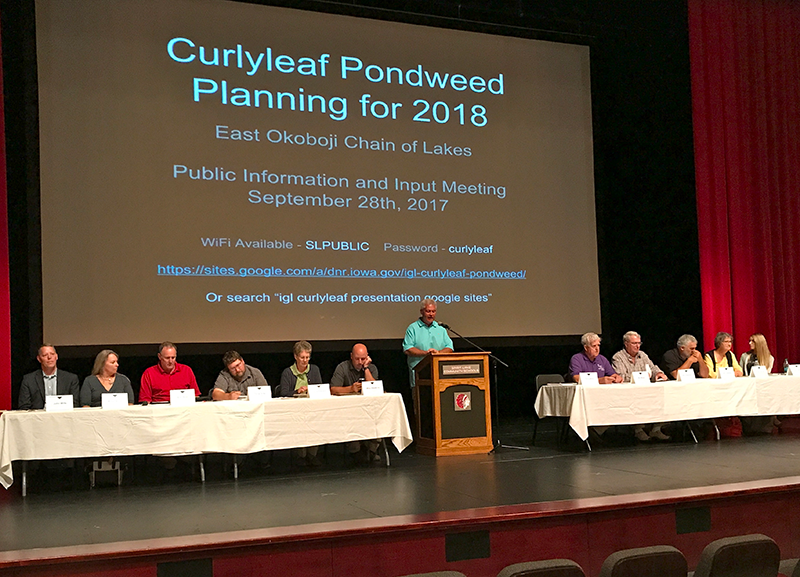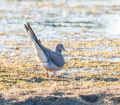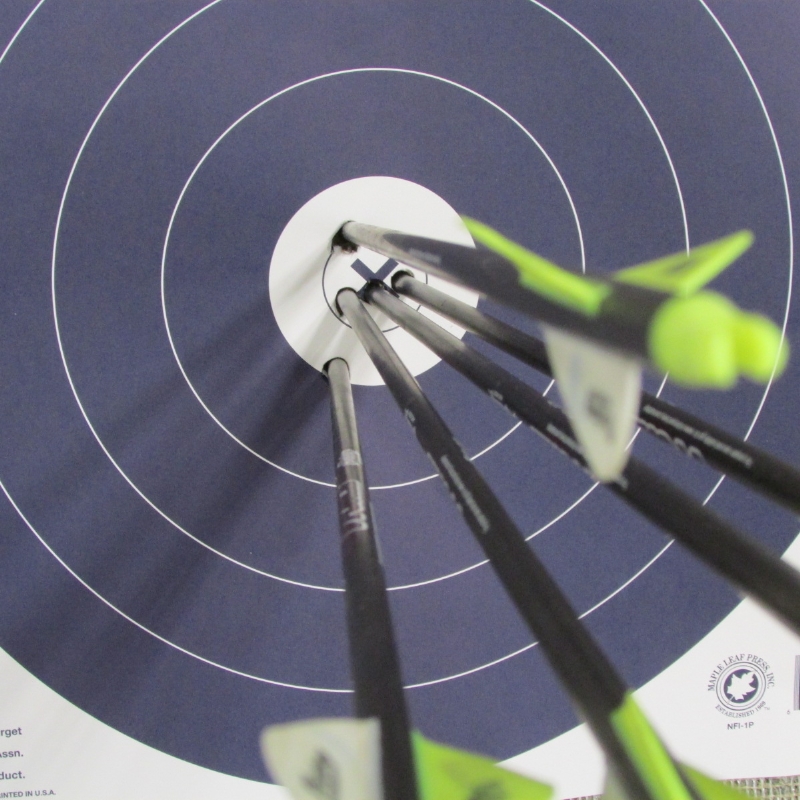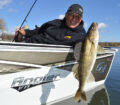By Steve Weisman
Over 100 concerned citizens attended a public meeting at the Sami Bedell Center on the Spirit Lake High School campus Thursday evening, September 29 to learn the recommendations of the stakeholder committee formed several months ago to address the issues and how to manage the invasive curlyleaf pondweed on East Lake Okoboji.
As I entered the center, I wondered how the meeting would go. After all, this has been a hot and volatile topic for the past three years. After the meeting, I came away impressed with the efforts and cohesiveness of the committee, the thoughtful questions posed by members of the audience and the fact-based answers provided by different committee members.
The committee, made up of leaders from the county, local cities, lake associations, drinking water utilities, Iowa Lakeside Lab and the Iowa Department of Natural Resources (DNR), had been working together over the past few months on a plan to manage an invasive aquatic plant that has caused water access and navigation issues for many Iowa Great Lakes residents and lake users.

Members of the committee include (L to R): John Wills, Coordinator of the Clean Water Alliance and President of Okoboji Protective Association; Mary Skopec, Director of Iowa Lakeside Lab; Eric Stoll, General Manager of the Milford Utilities; Tony Gray, Superintendent of the Central Water System; Julie Sievers, DNR Field Services; Mike Hawkins, DNR Fisheries Biologist; Terry Wilts, moderator and Secretary of the East Okoboji Lake Improvement Corporation; Bill Maas, President of the East Okoboji Lake Improvement Corporation; Phil Petersen, Executive Director of the Iowa Great Lakes Association; John Smeltzer, member of the Spirit Lake Protective Association Board; Pam Jordan, Vice Chair of the Dickinson County Board of Supervisor; Tanya Johnson, owner of Kabele’s Trading Post. Not in attendance Bill Van Orsdel, President of the Iowa Great Lakes Association; Blain Andera, Mayor of Spirit Lake.

Mike Hawkins giving the 45 minute background presentation to start the meeting.
With members of the committee sitting on the stage, Mike Hawkins, Iowa DNR fisheries biologist spent the first 45 minutes giving a quick summary of the history of curlyleaf pondweed, the positives and negatives of the plant, the need for balance between lake health and plant life and lake usability for people, including lake home owners, anglers and recreationists. He added that although aquatic plants can cause problems, in general, they are healthy for the lake. The alternative to aquatic plants is blue-green algae. The nutrients will show up in some form. He ended by saying, “It is not feasible to completely get rid of curlyleaf pondweed, and this committee is charged to help find a balance between plants and lake usability.”
2018 plan presented
The plan agreed upon by the committee was then presented. Hawkins began by saying, “One option is additional mechanical removal of curlyleaf pondweed beginning in mid-May that would be completed by Memorial Weekend. This year we did 18 acres using Underwater Solution’s mechanical harvester to cut a 15-foot wide swath between 100-150 feet out from shore to make navigation lanes. It is a slow process with only a five-foot swath, and every 15 minutes as the curlyleaf pondweed is harvested, the harvester becomes full and the curlyleaf needs to be dumped into a truck to be hauled away.” To increase the number of acres harvested, a second harvester would be on loan from Carter Lake near Council Bluffs. This harvester is much larger and will help achieve the goal of harvesting 40 acres, although it is more cumbersome and must be lifted by crane.
The second part of the plan includes chemically treating two 10-acre areas with Aquathol K, an approved aquatic herbicide. One area would be a 10-acre section at the north end of East Okoboji, while the other would be a 10-acre area on Lower Gar. Knowing that this part of the plan was the most controversial, Hawkins spent time explaining about Aquathol K and the process of application. “This particular herbicide has been safely used in 16 different lakes in Iowa. It is a contact herbicide, and application will take place in April. It breaks down within 10 days of application and begins diluting immediately. The EPA label places no restrictions on swimming, fishing or irrigating after treatment.”
The third part of the plan involves increased education and enforcement geared towards stopping the illegal application of herbicides by private lakeshore owners.
Total cost for the mechanical harvesting and chemical application will be approximately $40,000. A grant from the DNR through the Marine Fuel Tax will cover 75 percent of the cost, while the East Okoboji Lake Improvement Corporation and private donors will cover the other 25 percent.
Audience response
After the background presentation, the floor was opened for questions with Terry Wilts acting as moderator. Different members of the committee took turns answering the questions. Although there were other questions, the use of chemicals in the water brought forth several questions. One resident of Okoboji, was concerned about health. “First, Aquathol K has been used in many lakes in Iowa, but never for a drinking water source, and so that’s my first concern.”
Hawkins responded by acknowledging and understanding those concerns. “Both West Okoboji and Big Spirit are Class C lakes, which means they are designated as drinking water sources for human consumption. Although Aquathol K is approved by the EPA for use on these Class C lakes within 600 feet of an intake, we have no plans of doing so in West Okoboji. Neither East Okoboji or Lower Gar are Class C waters, and the test areas we have chosen are several miles from the closest water source, West Okoboji.”
According to Hawkins, personnel at the Iowa Lakeside Lab will be constantly monitoring the test areas to see how Aquathol K moves from the treatment area and how curlyleaf and other native plants respond.
A follow-up question was, “Why are we applying chemicals so quickly?” To which Terry Wilts responded, “We have been studying this for four years. We believe that it is time to act in a responsible way.” Committee member Mary Skopec followed up with the importance of the water monitoring and moving slowly with these small applications and documenting any movement and the fate of the chemical. “We do need to develop a baseline so that we have something to go by. In that way, we can assess and reassess as we go.”
A Milford resident continued to express concern for the drinking water. “We get our drinking water from West Okoboji. I am concerned for my family. How will it affect us?” Eric Stoll responded, “In looking at this issue, the committee has taken a lot of time to come up with the plan. We have been assured by the DNR that they will never apply in West Okoboji.” Stoll went on to say, “One of the big threats we’ve identified is individuals illegally applying chemicals to the lake to control weeds. Our plan includes education and enforcement of these laws. This will make our water safer.”
The concern of individual lake home owners taking matters into their own hands and treating weeds around their docks with herbicides was addressed several times. Committee member Bill Maas noted, “I had several calls this summer from residents saying that they saw their neighbors sprinkling chemical on weeds around their docks.” Maas called upon residents to take it upon themselves to not allow these actions to happen. Several in the audience wondered if there were any plans for educating people about this problem.
Hawkins said, “We are in the process of developing informational fact sheets and preparing other ways to educate people. I do want everybody to know that our enforcement officers and investigators with the Department of Agriculture can and will enforce these laws. I encourage people to let us know when they see this type of illegal activity. They can call us at the Hatchery or call our TIP line. Callers can remain anonymous.”
A lake home owner asked, “What about other areas? What can we do?” Hawkins noted that it is legal for people to mechanically harvest curlyleaf pondweed from around their docks, but that this can also become costly. He also reminded the crowd that this is a slippery slope. “We can’t treat everything. It’s not feasible and not in the best interest of the lake.
At this point, both Skopec and John Wills warned people that plants are good for water quality and that if we treat too much of the lake we can cause blue-green algae blooms. Skopec noted, “A blue-green algae bloom can be very toxic to both humans and pets. When in doubt, stay out!”
Another person asked, “What can homeowners do to keep nutrients out of the lake?” To which Wills said, “No matter what we do with curlyleaf pondweed next year, we also have to be thinking long-term about reducing runoff that brings in new nutrients that will impact our lakes. It involves all of us. Anything we can do to slow this down, the better it is for our lakes; we need to keep going and doing more.”
One resident’s comment brought a round of applause. “We are worried about this. We are losing our lake. We can’t just ignore this and forget about it!”
Toward the end, the audience learned that the committee plans on getting together soon to go over the comments of the evening and other comments received by phone and email to help determine if there needs to be any tweaks or changes to the 2018 plan. If needed, more public meetings will be held in the future to keep the public informed of the 2018 curlyleaf pondweed plan.
In an interview after the meeting, I visited with committee member Tanya Johnson, who along with her husband Thane own Kabele’s Trading Post. I mentioned how well it appeared that the committee members were on the same page. She said, “Each of us on this team has so much respect for one another because of our role and what each of us brings to the team. We have worked so hard together for many months and countless hours. We were all asked to be on this team. I was chosen to be on this team, and my role is to protect our fishery, the habitat and our fishing tourism. I am glad I was asked and proud to be a part of this committee.”

















